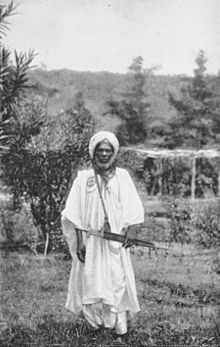Takouba
| Takouba | |
|---|---|

|
|
| Information | |
| Weapon type: | sword |
| Use: | Weapon, professional weapon |
| Distribution: | North and West Africa |
| Lists on the subject | |
The Takouba (also Takuba , Takoba , Takooba ) is an African sword . The Takouba was mainly used by the Tuareg , but also by other ethnic groups in large parts of North and West Africa .
description
The Takouba has a straight, double-edged blade . The blade tapers slightly from the vessel to the tip . The hilt has a short but wide quillons , which are usually wrapped in leather . The scabbard follows the shape of the blade, sometimes with a widened chape . The conical pommel is usually made of brass or copper .
A finished takouba was the result of the work of many hands. The blades usually come from Europe , scabbards and hangers were often made by the Hausa . The sword was made by local blacksmiths .
The Takouba is the mainly in Sudan occurring Kaskara similar. The Kaskara differs in the blade, which usually only tapers at the tip, the thinner quillons and the significantly widening sheath at the tip.
Occurrence and use
Originally the takouba was a weapon of the Tuareg, who mainly live in Mali , Algeria , Niger and Libya . The weapon also spread to the medium-sized landscape of Sudan , especially in northern Nigeria and neighboring regions. The sword was also used in the empire Kanem-Bornu and in the Sultanate of Baguirmi as far as Chad . Takoubas can also be found among the Hausa , Fulbe , Nupe and other neighboring ethnic groups.
The Takouba is at waist level, on a bandolier of wool worn. The sword was used by the Touareg together with a shield .
history
Because of the cross-shaped vessel, which resembles the European swords, in the 19th century African explorers ascribed an influence of the crusaders . Although the Crusaders were active in Egypt and Tunis ( Seventh Crusade ), there is no evidence of any use of European swords outside of Egypt.
It is more likely that the straight North African swords descended from the medieval Arabic swords. These also had straight blades. The typical curved shape did not appear until the 15th century. The Arabs crossed the Sahara in the middle of the 8th century and could have influenced the local blacksmiths in this way.
From the 15th century, European blades came to Africa via Mediterranean or Atlantic ports . First the Portuguese set up trading posts in Mauritania . The European blades were probably not used to build straight North African swords until the 16th century, when the import of blades from Spain , Italy and Germany increased significantly. Vessels and sheaths were made in trade and craft centers such as Kano in Nigeria. But local blades were also forged, some with forged European fittings , which makes it difficult to classify them precisely.
With the Tuareg, the takouba was reserved for certain social hierarchies in pre-colonial times. The Tuareg clung to the traditional weaponry of spear and sword until about 1914 , but the unrest in World War I during the Italian colonial period called for a restructuring of the armament to modern firearms.
The Takoubas are rarely seen in everyday life , but they still remain valuable possessions and are worn as prestige weapons at festivals such as camel races .
literature
- Christopher Spring : African arms and armor , Smithsonian Institution Press, 1993, ISBN 978-1-56098-317-0
- Manfred A. Zirngibl , Alexander Kubetz: panga na visu. Handguns, forged cult objects and shields from Africa. HePeLo-Verlag, Riedlhütte 2009, ISBN 978-3-9811254-2-9 , pp. 21–22 Fig. 5–7, pp. 265–266
- Johanna Agthe, Karin Strauss, Joseph H. Oluoch, John AR Wembah-Rashid: Before the guns came , Museum für Völkerkunde , Frankfurt am Main, 1985, ISBN 3882703539
Web links
- Takouba Research Society
- Copy from the Bath Royal Literary and Scientific Institution
- Takouba at Sahelarms.com ( Memento from February 1, 2013 in the web archive archive.today )
- Lee A. Jones: Takouba at vikingsword.com
- Takouba at Oriental-Arms
Individual evidence
- ↑ Spring: African arms and armor , 1993, p. 40
- ↑ Spring: African arms and armor , 1993, p. 30
- ↑ Spring: African arms and armor , 1993, p. 30
- ↑ Spring: African arms and armor , 1993, p. 41
- ↑ Spring: African arms and armor , 1993, pp. 40-41
- ↑ Karin Strauss: Weapons in Kanem-Bornu and Bagirmi in: Before the rifles came p. 83
- ↑ Spring: African arms and armor , 1993, p. 41
- ↑ Spring: African arms and armor , 1993, p. 41
- ↑ Spring: African arms and armor , 1993, p. 30
- ↑ Spring: African arms and armor , 1993, p. 42
- ↑ Karin Strauss: Weapons in Kanem-Bornu and Bagirmi in: Before the rifles came p. 83
- ↑ Spring: African arms and armor , 1993, p. 42
- ↑ Spring: African arms and armor , 1993, p. 42
- ^ Anthony North: Swords of Islam in: Swords and hilt weapons , Barnes & Noble , 1989, ISBN 1566192498 , p. 139
- ↑ Spring: African arms and armor , 1993, p. 42
- ↑ Spring: African arms and armor , 1993, pp. 40-42
- ↑ Spring: African arms and armor , 1993, p. 28
- ↑ David Nicolle: Lawrence and the Arab Revolts , Osprey Publishing , 1989, ISBN 9780850458886 , p. 10 [1]
- ^ Helene E. Hagan: Tuareg Jewelry: Traditional Patterns and Symbols , Verlag Xlibris Corporation, 2006, ISBN 9781477165607 , p. 66 [2]
- ↑ Spring: African arms and armor , 1993, p. 28


